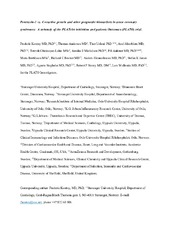| dc.description.abstract | <i>Aims</i>: We investigated the dynamics, associations with patient characteristics, other biomarkers, and clinical outcomes of pentraxin 3 in acute coronary syndrome.<p><p>
<i>Methods and results</i>: In multivariate analyses, pentraxin 3 measured in 5154 patients randomised in the Platelet Inhibition and Patients Outcomes (PLATO) trial (NCT00391872) was compared with leukocytes, high-sensitivity C-reactive protein, interleukin-6, cystatin C, N-terminal prohormone brain natriuretic peptide, high-sensitivity troponin T and growth differentiation factor 15 concerning prediction of clinical outcome. Pentraxin 3 peaked earlier than high-sensitivity C-reactive protein and was more strongly correlated with N-terminal prohormone brain natriuretic peptide and high-sensitivity troponin T than with high-sensitivity C-reactive protein. The frequency of cardiovascular death, spontaneous myocardial infarction or stroke by quartiles of pentraxin 3 at admission was 6.1%, 7.3%, 9.7% and 10.7%, respectively (<i>p</i><0.0001). The hazard ratio per 50% increase of pentraxin 3 was 1.13 (95% confidence interval: 1.07–1.19), <i>p</i><0.0001. This association remained significant after stepwise adjustments for leukocytes/high-sensitivity C-reactive protein (1.09 (1.02–1.15)), <i>p</i>=0.009, interleukin-6 (1.07 (1.01–1.14)), <i>p</i>=0.026, and cystatin C (1.07 (1.00–1.13)), <i>p</i>=0.044, but not after adjustment for N-terminal prohormone brain natriuretic peptide, high-sensitivity troponin T and growth differentiation factor 15. Admission pentraxin 3 was also associated with several of the individual endpoint components (cardiovascular death/spontaneous myocardial infarction; <i>p</i>=0.008, cardiovascular death; p=0.026, and spontaneous myocardial infarction; <i>p</i>=0.017), but not with stroke. Pentraxin 3 measured in the chronic phase (i.e. at one month) was still predictive of the composite endpoint in univariate analysis (1.12 (1.04–1.20) per 50% increase) <i>p</i>=0.0024, but not after adjustment for the other biomarkers.<p><p>
<i>Conclusion</i>: Admission level of pentraxin 3 is a modestly stronger predictor than high-sensitivity C-reactive protein and interleukin-6, but not than N-terminal prohormone brain natriuretic peptide or high-sensitivity troponin T, concerning cardiovascular outcome in acute coronary syndrome. Pentraxin 3 is more strongly correlated with N-terminal prohormone brain natriuretic peptide and high-sensitivity troponin T than with high-sensitivity C-reactive protein. | en_US |
| dc.identifier.citation | Kontny F, Andersen T, Ueland T, Åkerblom A, Lakic, Michelsen A, Aukrust P, Bertilsson M, Becker RC, Himmelmann A, James SK, Siegbahn A, Storey RF, Wallentin L. Pentraxin-3 vs C-reactive Protein and Other Prognostic Biomarkers in Acute Coronary Syndrome: A Substudy of the Platelet Inhibition and Patients Outcomes (PLATO) Trial.. European heart journal. Acute cardiovascular care.. 2019 | en_US |


 English
English norsk
norsk